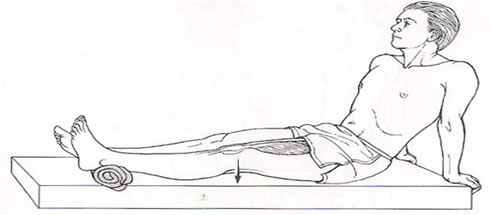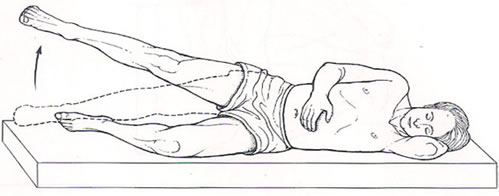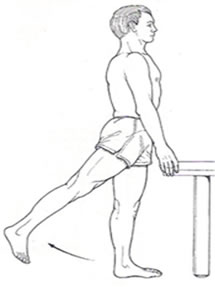The home exercise programme will assist your recovery and improve strength. It is important that you take time to exercise every day. The exercise programme will take approximately 30 minutes to complete and should be done two to four times per day. Recovering from a total knee replacement and returning to a more active lifestyle will take time depending on the efforts you put by strictly following the guidelines given to you.
- It will take approximately 3 months for the swelling in your knee to go down. So, it is important to ice your knee 3-4 times per day for at least first 6 weeks after surgery. This should be done for 10-20 minutes at a time. The best time to ice is after you exercise or do a lot of walking. To ice, you can use Zip Lock Bags filled with ice or two large Gel Packs. The best way for icing your knee is with the knee straight and a towel rolled under your ankle.
- Try not to sit for more than 45 minutes at any given time because your knee may become stiff and/or the entire leg may become swollen. If you wish to sit for longer periods of time, e.g. watching a movie or TV, you should stand and walk a short distance and try to bend and straighten your knee several times.
- Do not sleep or sit with anything under your knee i.e. a pillow.
- If anytime you notice persistent fever, swelling, pain or drainage from your wound, immediately contact Dr. Mihir Mehta.
- It is important that all physicians and dentists treating you should know that you have a joint prosthesis. You will require antibiotics before and after any invasive procedure or dental work to protect against infection. Also, if you get infection anywhere else in the body e.g. urinary infection, dental infection etc., it should be promptly treated with antibiotics to prevent infection traveling to your implanted knee joint. This is particularly more important during the first year after surgery.
- Your new knee may activate metal detectors at airports and other places. You are advised to carry certificate from your doctor regarding this while traveling.
General Advice
- Posture
- Remember at all times to sit and walk straight with shoulders back.
- Walking
- Do not limp. Try to use your new knee; bend your knee as you bring your leg through on each step.
- Walking Aid
- Continue using your walking aid until you have been asked to do so. If you use one stick, always use it in the opposite hand to your operated leg.
- Stairs
- Go up with your Good leg first, then your operated leg and stick together. Go down with your stick and operated leg first, then your good leg.
- Sitting
- Sit straight in your chair, bend your knees. Don’t sit with your knees at an awkward angle.
- Driving
- Avoid driving for at least 6 weeks.
Home Exercise Programmes following your total knee replacement
- Please do each exercise 30 times, twice a day.
- Do not hold your breath while exercising.
These exercises are the most important for your knee
Ankle Pumps
Lie flat on your back with your knee straight. Bend ankle up and down as far as possible in both directions. Do this exercise on both sides.

Heel Slides
Lie flat on your back with your knees straight. Slowly slide your heel towards your buttocks and then straighten to the starting position. Keep your foot on the surface at all times.

Knee Press
With your legs straight and a folded towel under your ankle, press knee down for contracting your thigh muscles. Hold for 5 seconds and then relax. Repeat with the other leg.

Straight Leg Raise
Lie flat on your back. Bend the non-operated leg with its foot flat on the surface. Tighten your thigh and lift your operated leg. Keep your leg straight. Only lift to the height of the other knee. Repeat with the other leg.

Side Lying Abduction
Lie on your non-operated side and bend your non-operated leg forward. Raise the operated leg about five inches up and bring it down to the starting position. Repeat with the other leg.

Sitting Knee Extension
Sit in a chair. Straighten your operated knee as far as you can. Hold for 5 seconds and then bring it down. Repeat with the other leg.

FOR ALL STANDING EXERCISES, MAINTAIN UPRIGHT POSTURE.
Standing Knee Bending
Holding a supportive surface like top of table or kitchen platform, bend your operated knee so that your foot rises towards your buttock. Perform the same with your non-operated leg.

Standing Hip Bending
Holding a supportive surface like top of table or kitchen platform, lift your knee up towards your shoulder by bending at the hip and knee. Perform the same with your non-operated leg.

Standing Hip Abduction
Holding a supportive surface, bring your operated leg out to the side keeping your toes pointing forward. Then perform with the non-operated leg.

Standing Hip Extension
While holding on to a supportive surface, bring your operated leg back keeping your knee straight.

Standing Terminal Knee Extension
While holding on to a supportive surface, bend your operated knee slightly. Gently pull back your knee by tightening your thigh muscles straightening your knee. Hold for 5 seconds.

Heel Raises
While holding on to a supportive surface, lift both heels off the ground toward the ceiling. Hold for 5 seconds and then slowly return to the starting position.

Sitting Assisted Knee Bending
While sitting in a chair with your non-operated leg crossed in front of your involved ankle, push your operated foot backwards assisting with the bending of the knee. Hold for 5 seconds.


